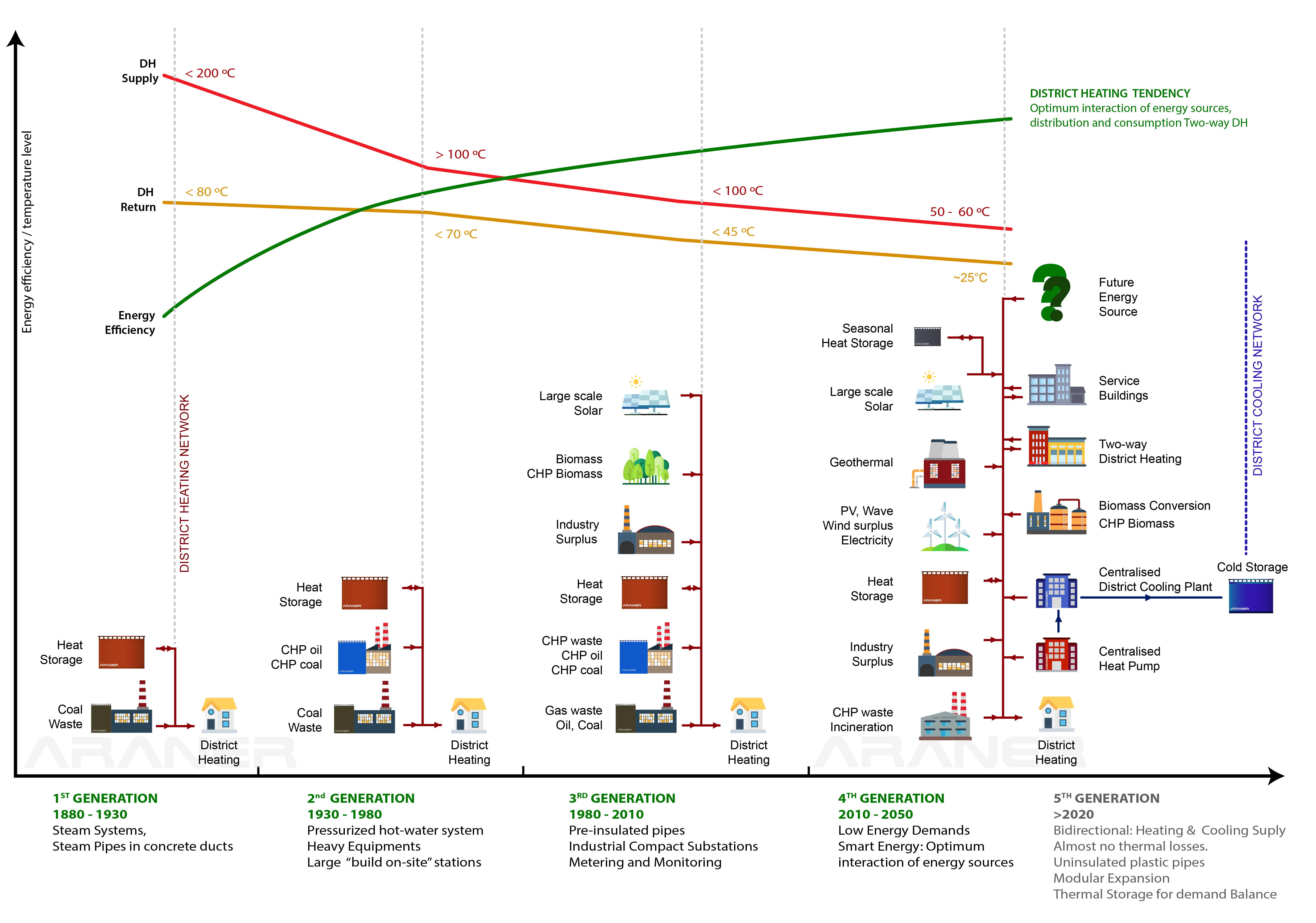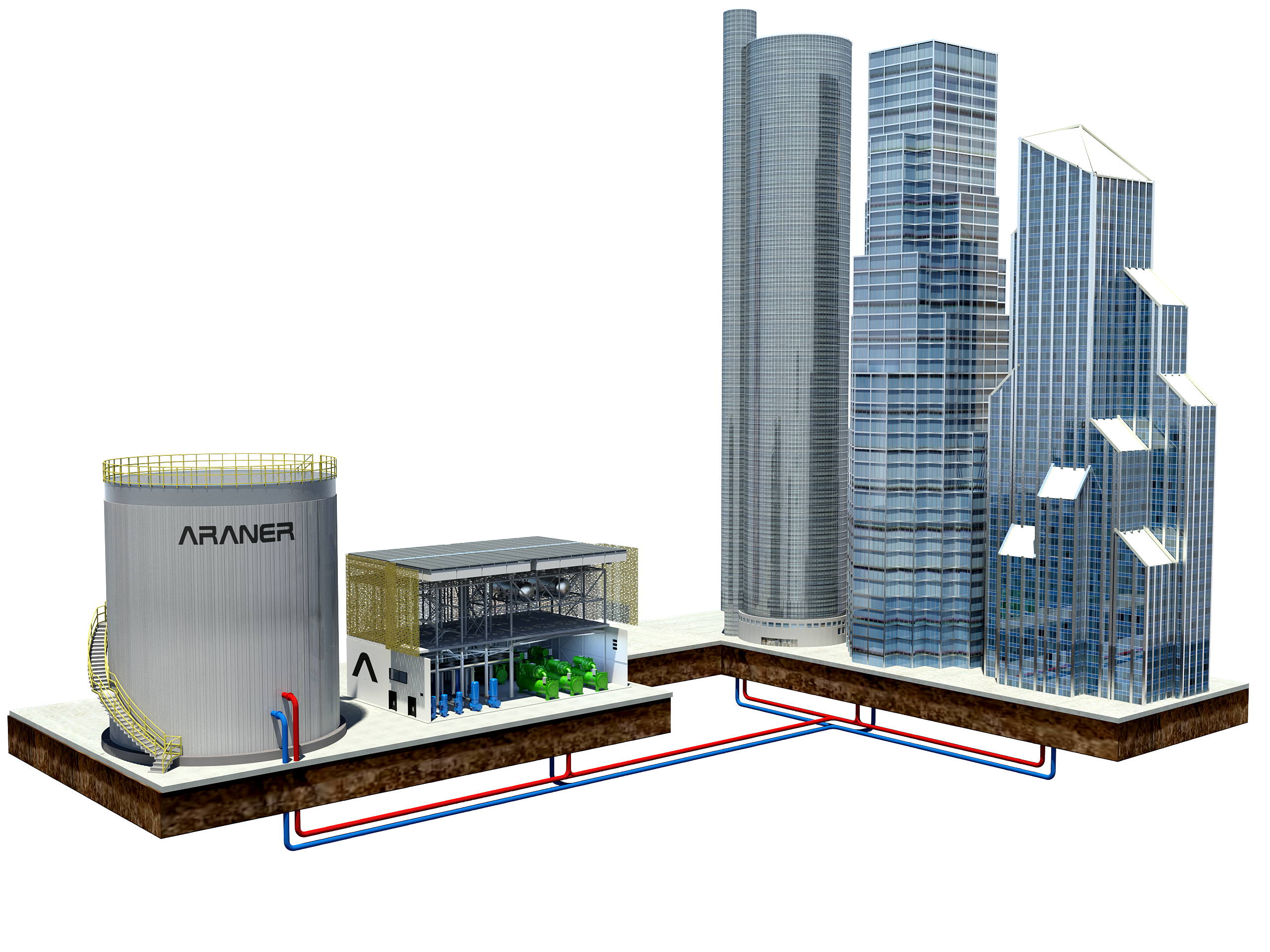As new energy targets are putting all heating and cooling systems to the test, all actors in the energy industry are currently in search for sustainable, efficient systems. The inclusion of an ambient loop system stands out as a key solution to enhance District Heating networks and guide them towards increased resource optimization.
Learn what exactly is an ambient loop system and the new possibilities opened up by ambient loop district energy.
What is an ambient loop system?
An ambient loop system operates at significantly lower temperatures than traditional communal high temperature heating systems. It is like a district cooling or district heating, but sending the water at medium temperature in the distribution network. Then each building can have its heat pump to use this ambient loop as an unwanted heat source, giving or taking heat from it. That is, evaporate or, if it is summer, condense. It also serves to balance the network if there are different types of consumers, some cold and others hot.
Current successful applications of the ambient loop heat network are being explored in District Energy models, which have been hailed as one of the most efficient and sustainable alternatives to solve heating and cooling needs in cities today.
As such, the ambient loop system complements District Heating solutions, which typically include a centralized model, allowing for increased efficiency by improving its distribution processes. Thanks to the ambient loop, the plant can operate at lower temperatures and using lower flow rates, resulting in less distribution losses between the centralized plant and each individual building.
The ambient loop system, working in conjunction with other efficiency maximizers such as large-scale heat pumps results in unprecedented energy optimizations.
In fact, successful models have been described by Marques et al., including the outstanding example of the London Borough of Islington. After declaring a commitment to guaranteeing carbon neutrality by 2030, a low carbon energy system was devised which combined 3 different district heating networks into a modern 5th Generation District Energy model that would serve around 33,000 citizens.
As a way to optimize efficiency and guarantee energy losses were minimized, an ambient loop system was integrated in the network. As described by the author of the text, this system performed two key measures:
- It was able to recover waste heat from the London Underground in order to repurpose it as useful energy
- It facilitated the interchange of heating and cooling between buildings according to actual demands, enabling a sharing model between buildings that activated economic savings and minimized the system’s environmental impact.

The benefits of an ambient loop system
- As described above, the main benefit of including an ambient loop system in district heating is minimizing system energy losses, as the ambient loop is able to keep temperature gradients more homogeneous, reducing differences between network and ambient temperatures. This efficiency solves loss issues that typically occur in high-temperature systems, where distribution networks are troubled by distribution issues and can cause overheating problems, among other difficulties.
- A natural consequence of this reduction of energy losses is the enhancement of a district energy system’s efficiency. This is particularly true if the system employs heat pumps, which are able to optimize energy efficiencies to unparalleled levels, as illustrated by the case of Islington mentioned above. At the same time, the incorporation of smart systems and 5th generation district energy encourages further energy optimizations that turn into economical savings and an improved sustainability.
- Economical savings linked with an ambient loop system are not just related to energy efficiencies: the inclusion of such a system allows for less capital expenditures in the generation of district energy networks and infraestructures. This is because improved operating temperatures will also typically mean pipe networks are not in need of extensive insulation (or that insulation can be added to specific areas). Another additional economical benefit of improved operating temperatures is that pipes will present an extended working life, and maintenance needs will be minimized.
- The inclusion of an ambient loop system is certainly advantageous in terms of advancing towards improved sustainability. This is because it facilitates the generation of energy efficiencies, but also allows for the improvement of already efficient district energy systems. In fact, a study by Revesz et al. can provide a glimpse into the carbon savings activated by ambient loop models: the described system is based on heat pumps as distributed energy centres, providing heat that is then delivered efficiently by the ambient loop system. The particular case shown in this study resulted in saving 5,000 tons of CO2e annually.

Why an ambient loop heat network is the future for District Heating
The heating industry is at a crossroads where innovative, efficient solutions are being experimented with in order to limit environmental impacts while providing comfort to citizens.
In such a context, District Heating stands out as one of the key models showing consistent improvements in terms of sustainability but also from an economical point of view.
The key to success in District Heating lies in this model’s capacity for centralization, where a single plant concentrates the whole energy production and then is in charge of redistributing it. Through the employment of the most sustainable energy sources for district heating, it’s possible to switch whole urban centers towards energy efficiencies and carbon-neutral models.
The use of large-scale heat pumps remains a central aspect of these systems’ efficiency: while direct electric heating can reach conversion efficiencies of around 100%, the use of industrial heat pumps can improve this efficiency to up to 250-400%.
The final addition to these exceptional heating models is the inclusion of an ambient loop system, which comes to improve efficiency by creating a smaller temperature gradient that, in turn, guarantees less electricity is required to generate the same heating energy. As we’ve seen in this article, the ambient loop thus solves distribution inefficiencies.
This model, which may also be combined with avant-garde thermal storage systems, provides a hopeful outlook for the District Energy landscape, a system which is being consistently preferred by developers and public institutions as the solution to provide citizens with sustainable heating.
At Araner, we stand at the forefront of energy innovation through our District Energy projects. Working with the most sophisticated tools in the market and applying innovative project management methodologies, we’re able to devise and implement energy systems that match each project’s particular needs.
Want to learn more about District Heating and how it’s helping developers and institutions meet sustainability standards as well as achieving operational efficiencies and economic savings? Download our District Heating Reference book or get in touch with us to speak to our team.










